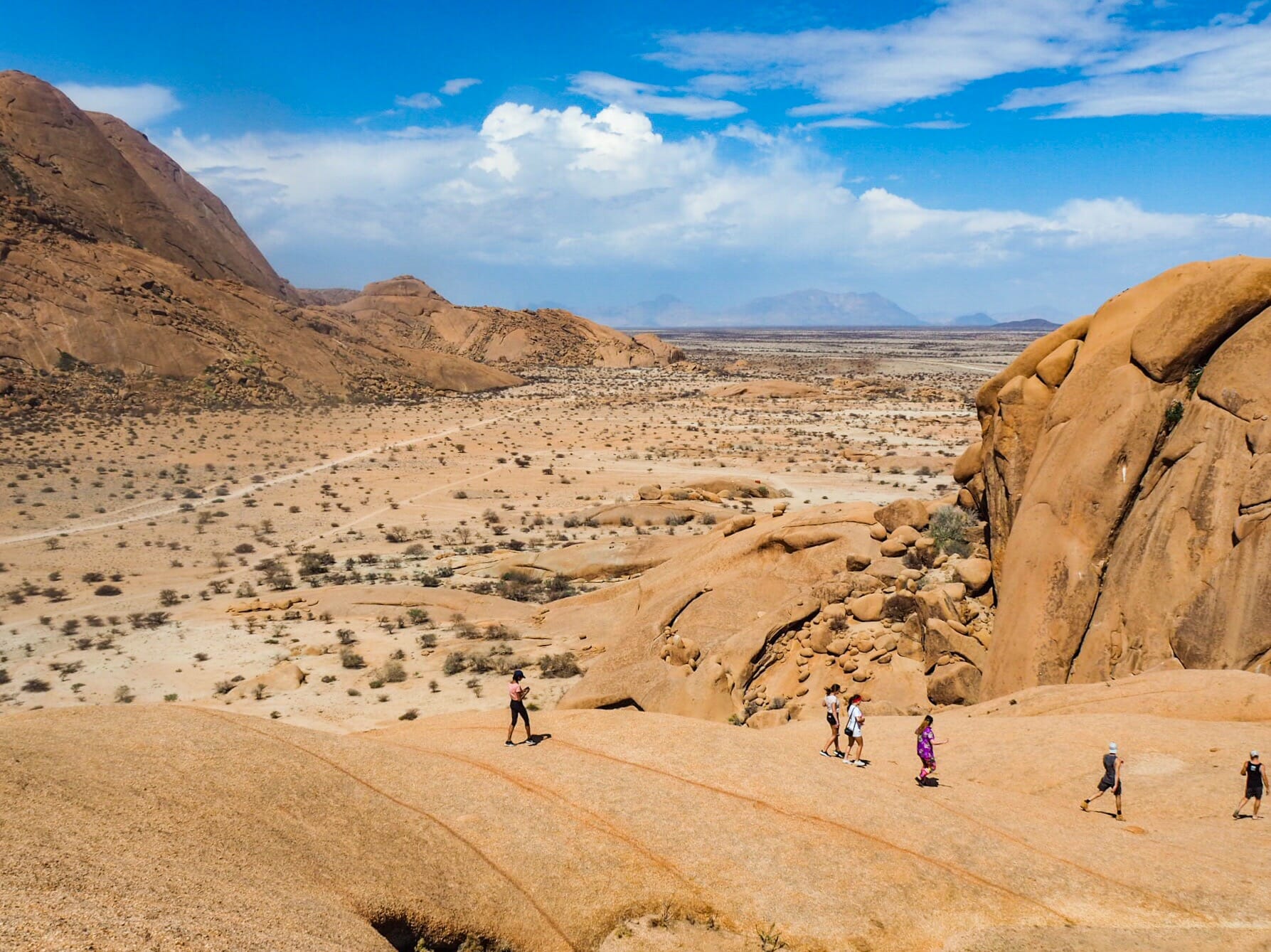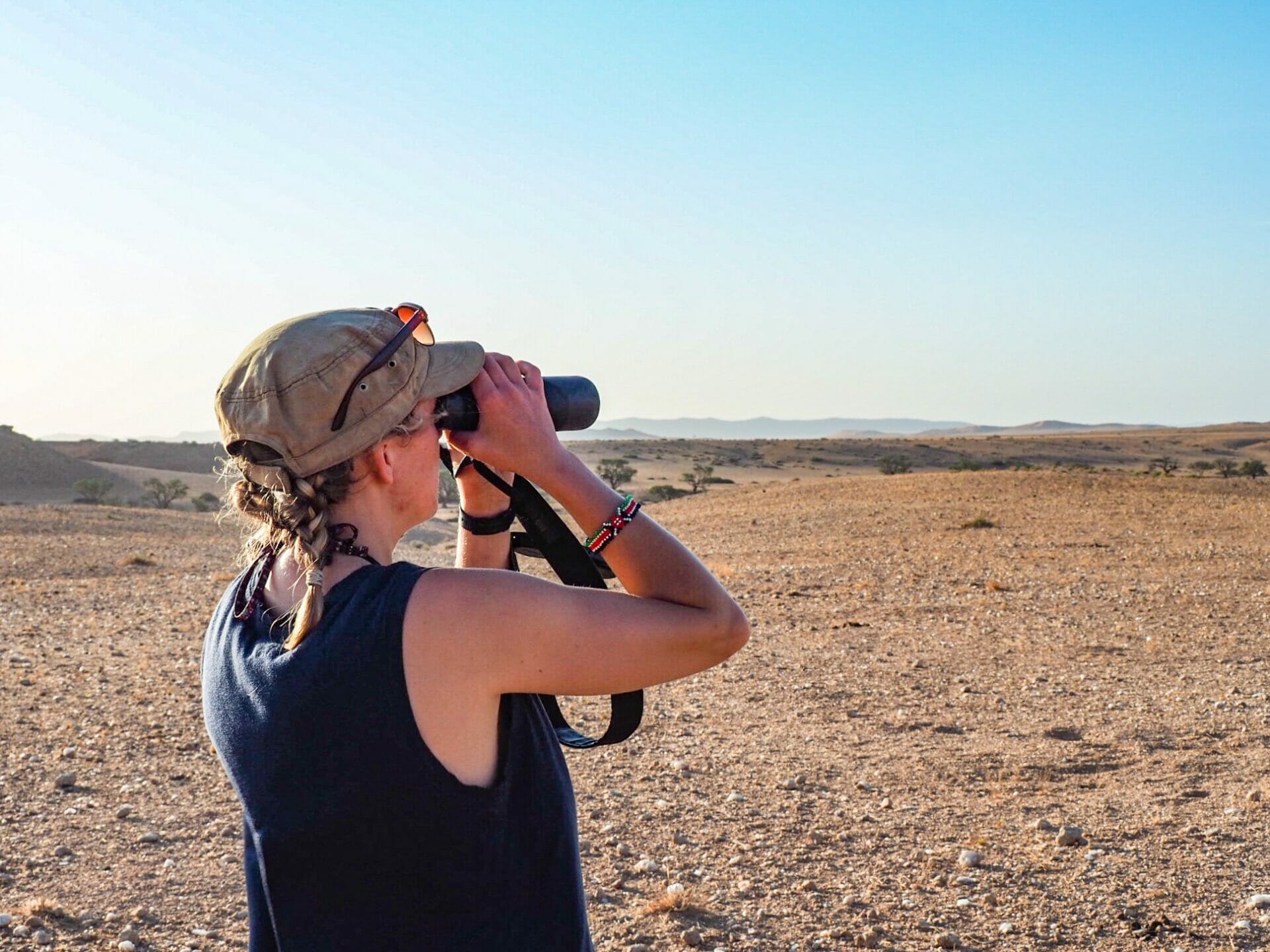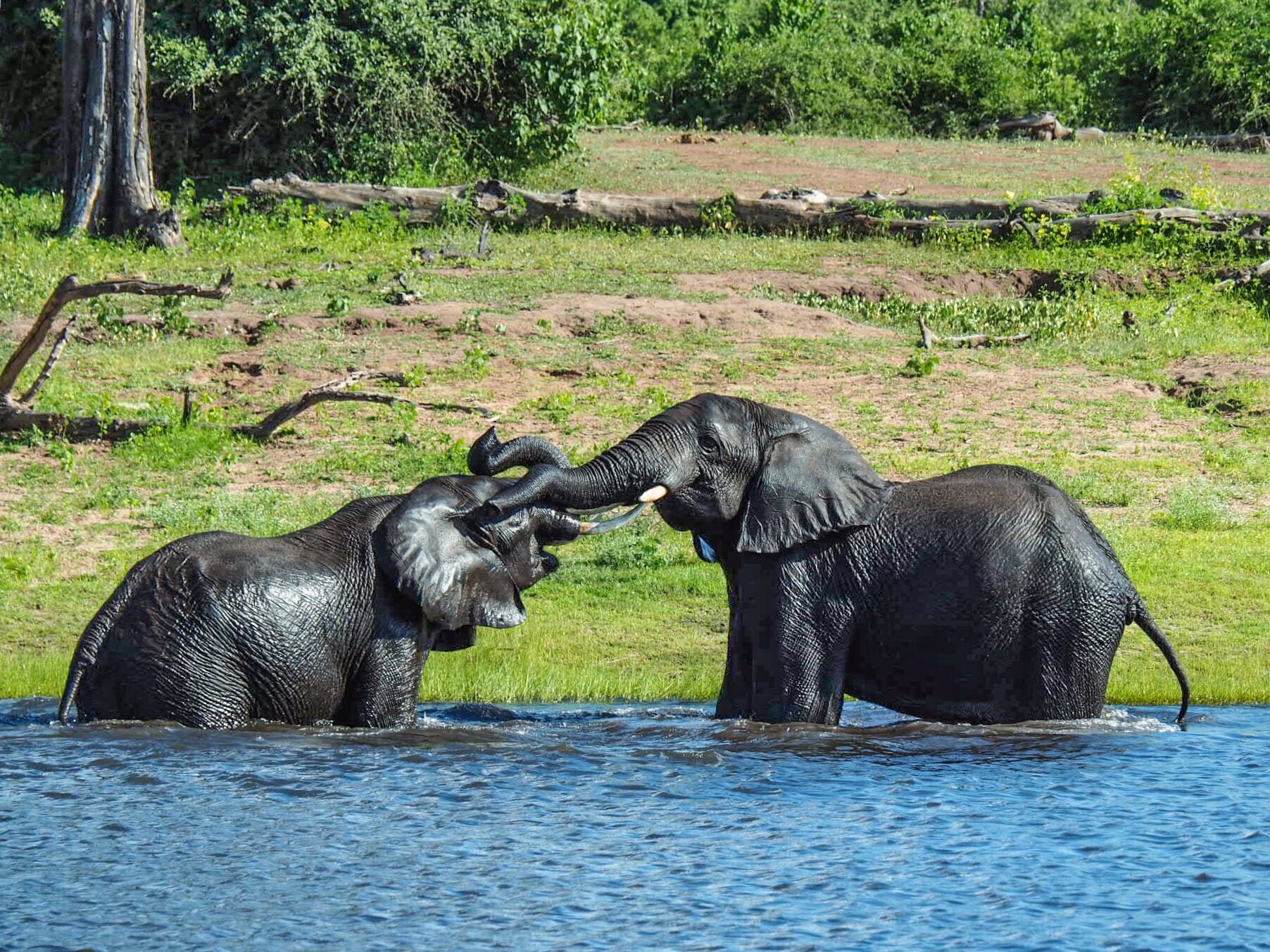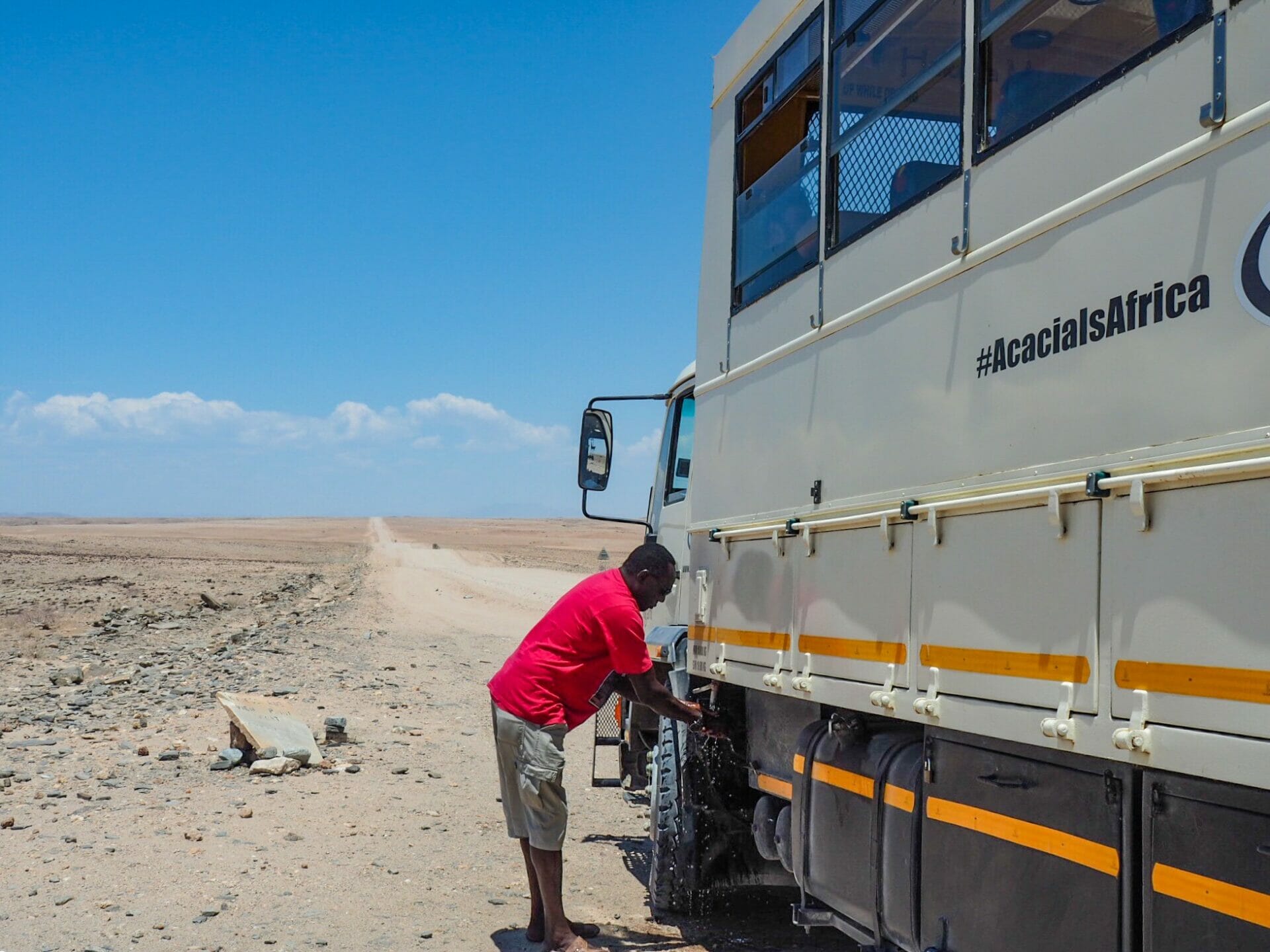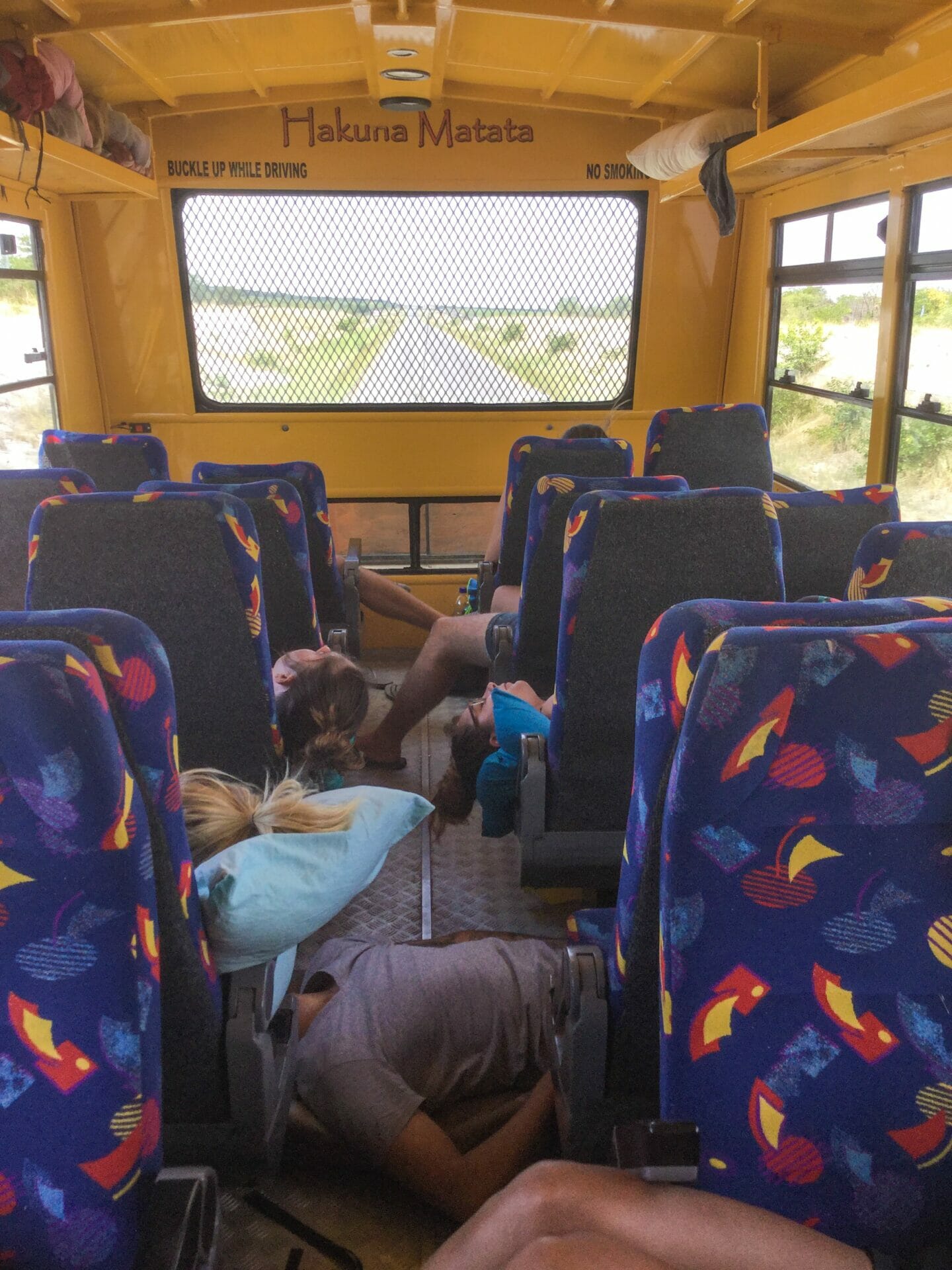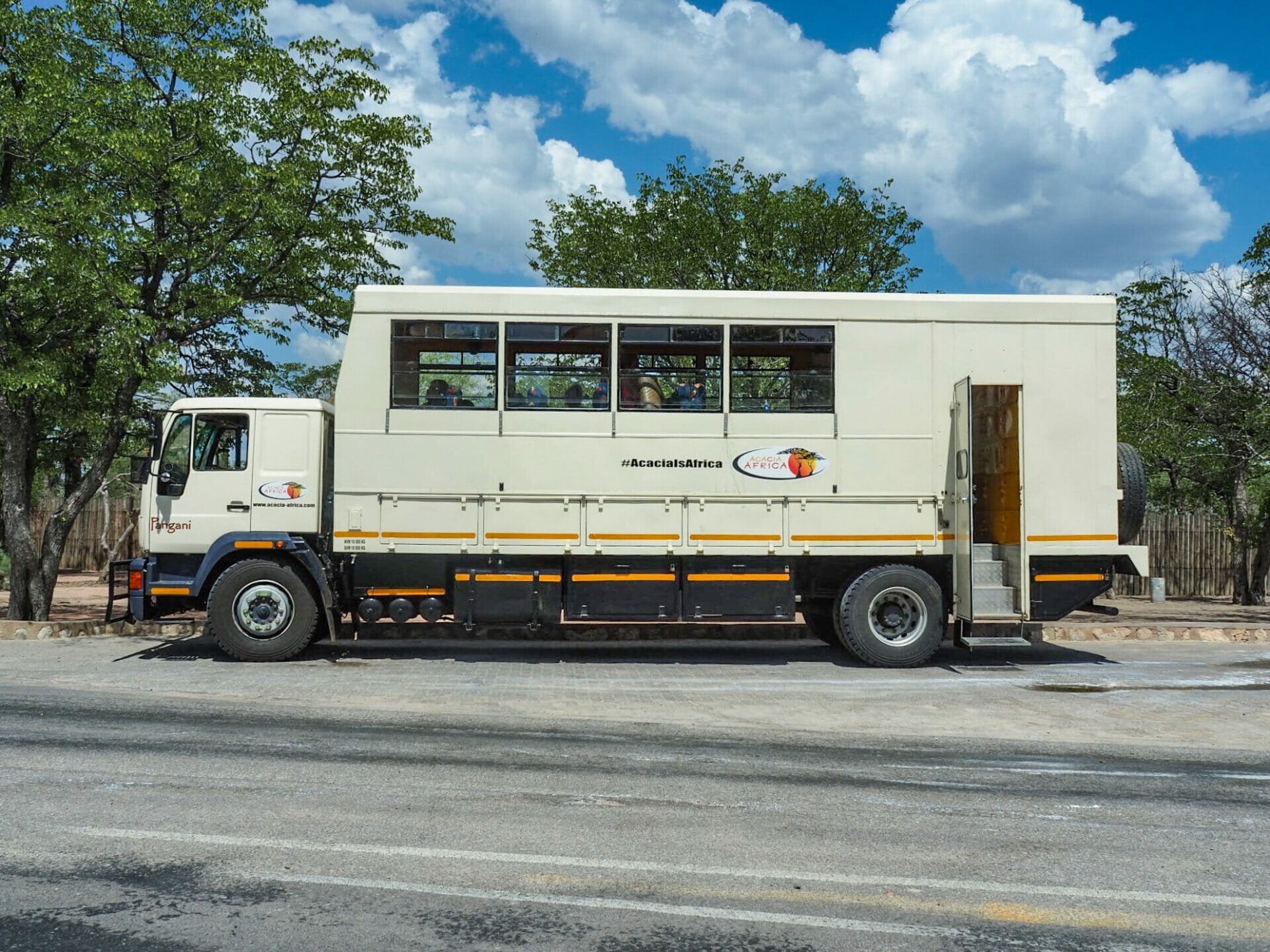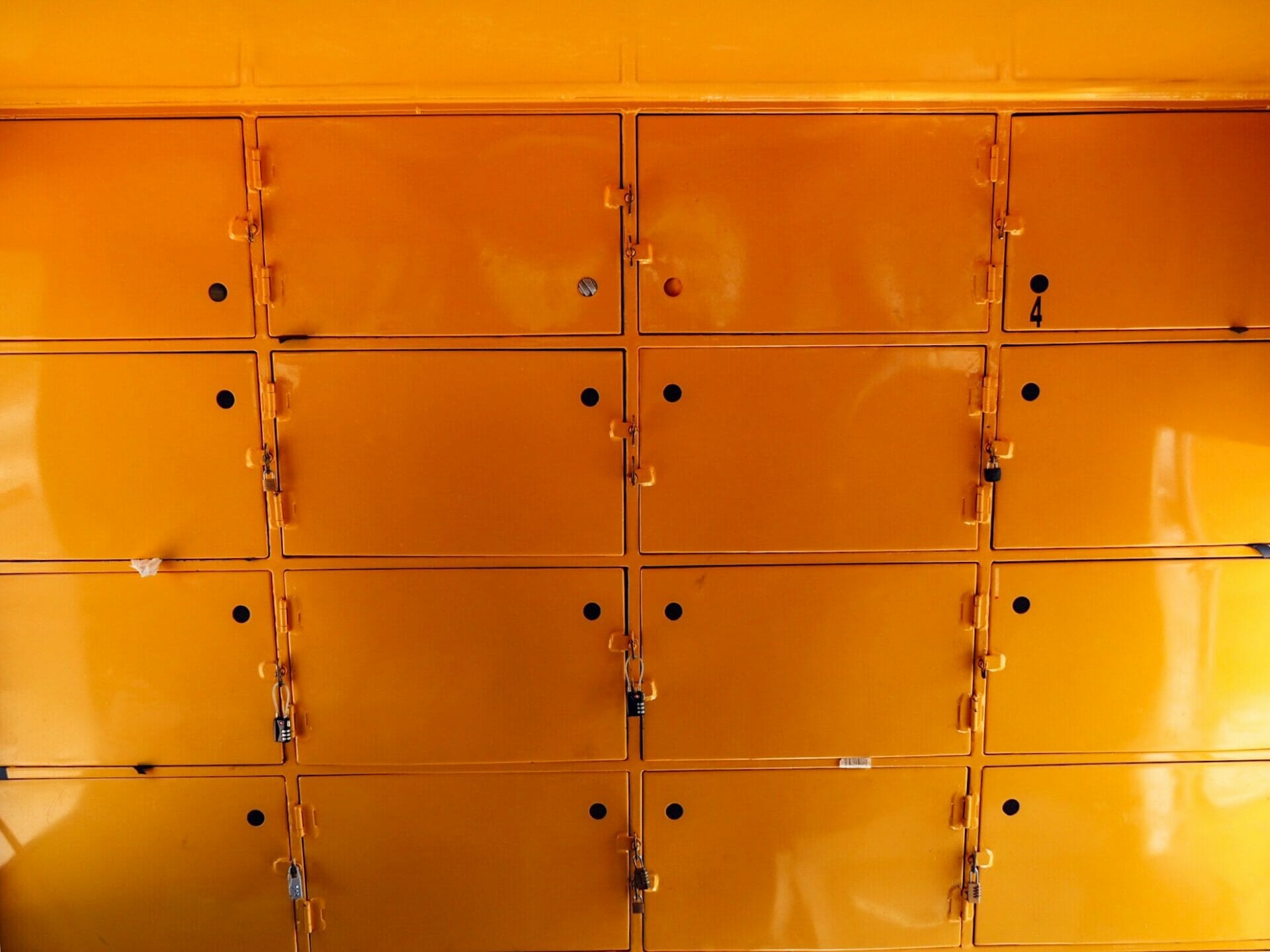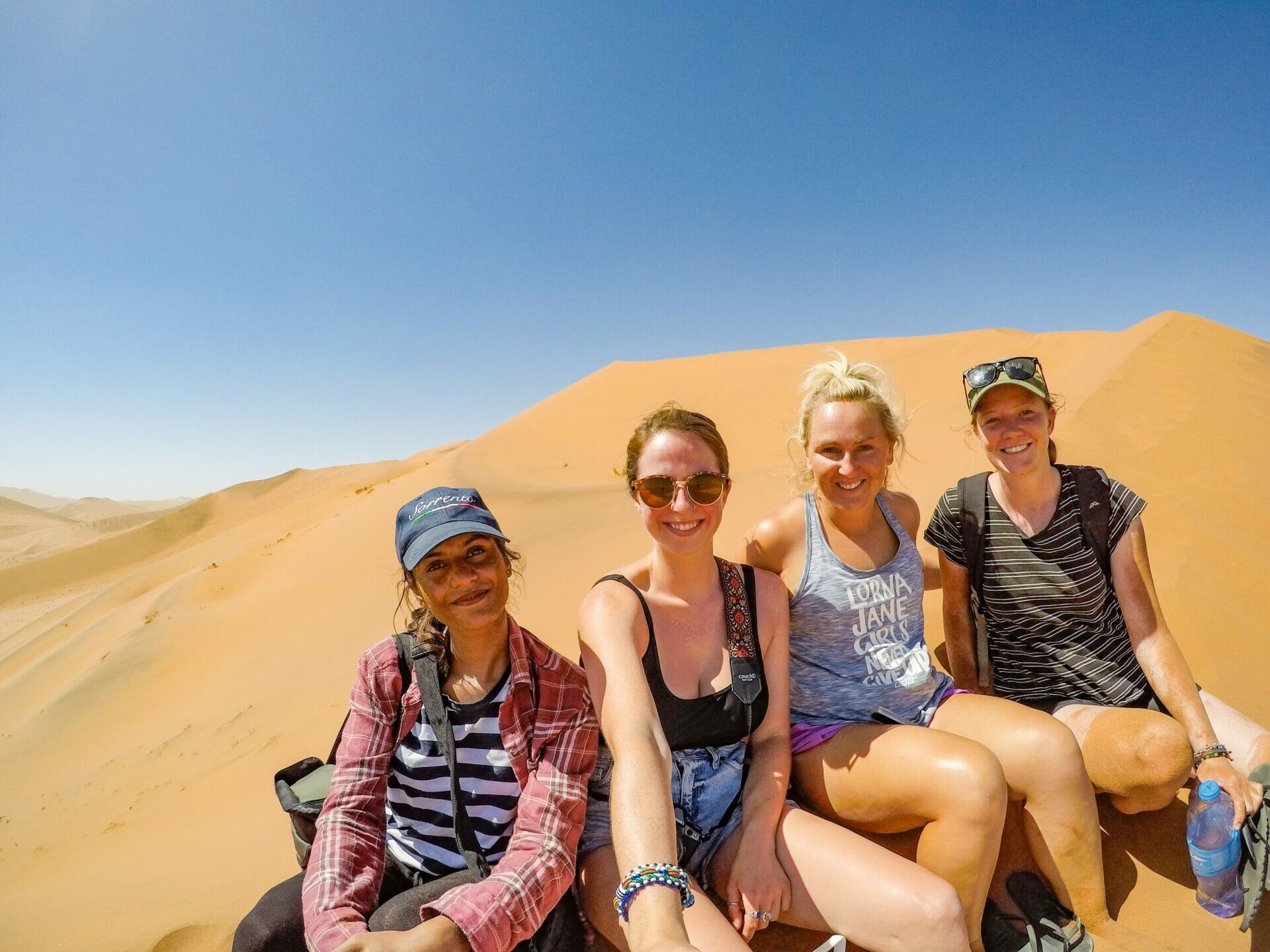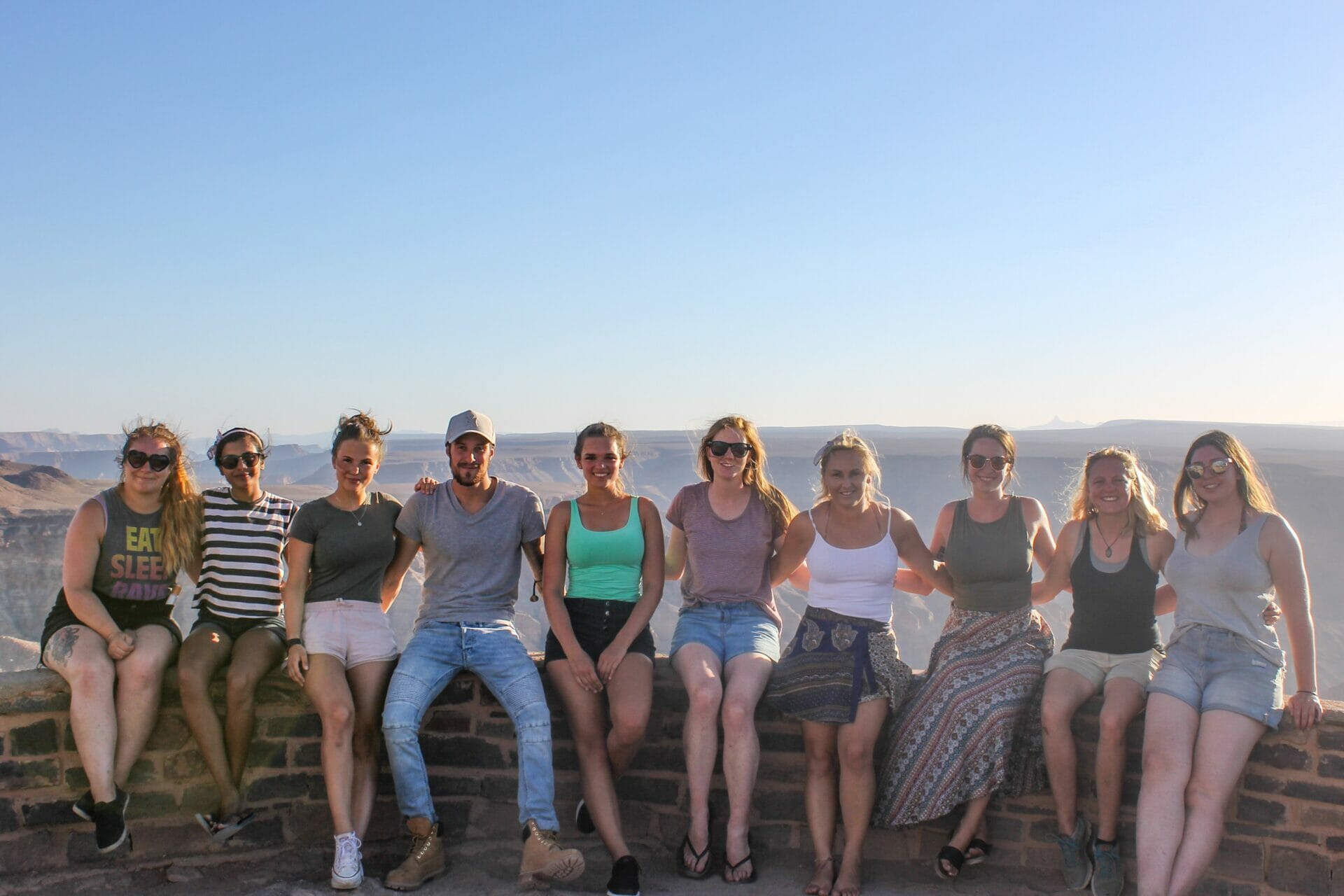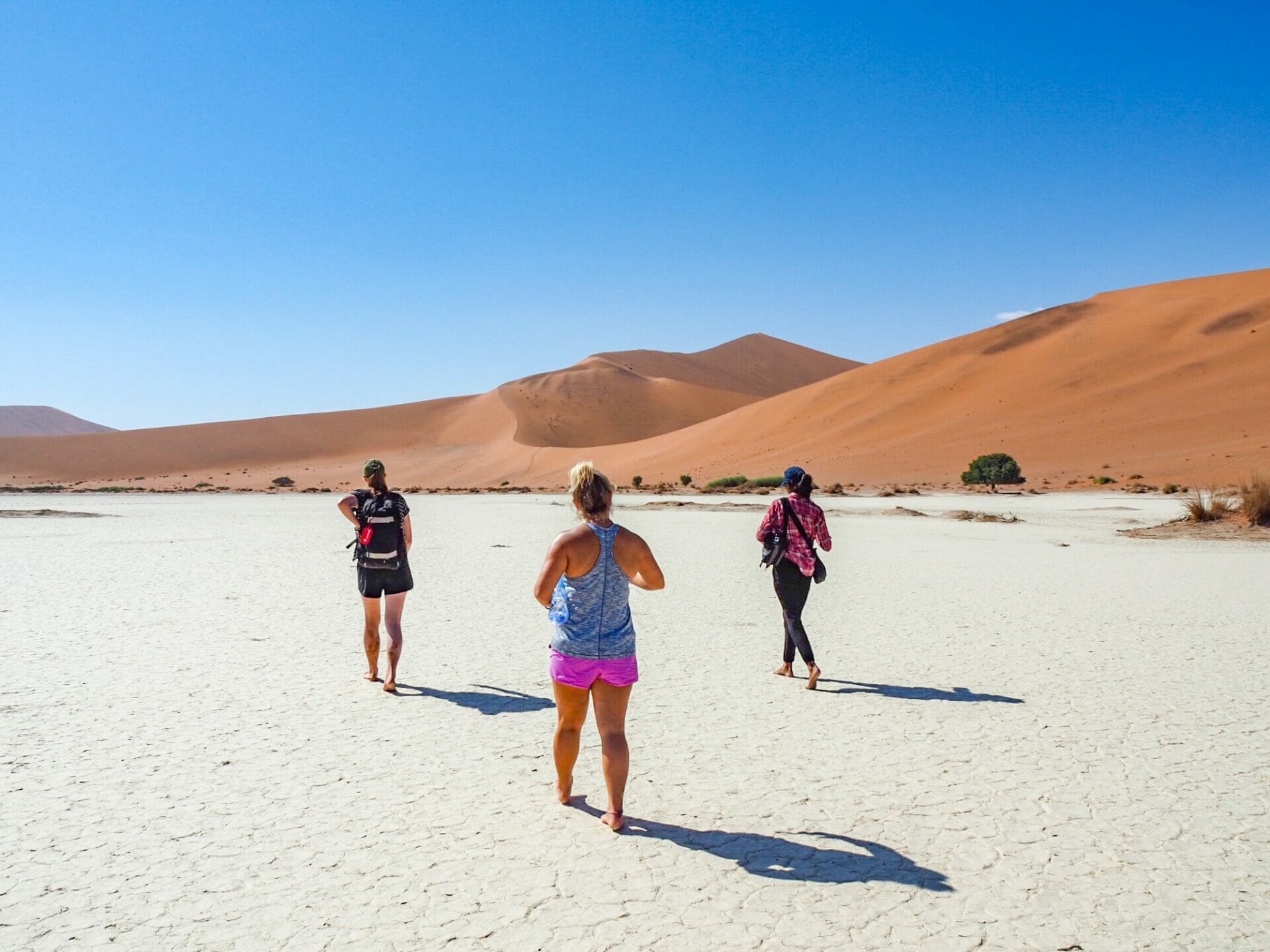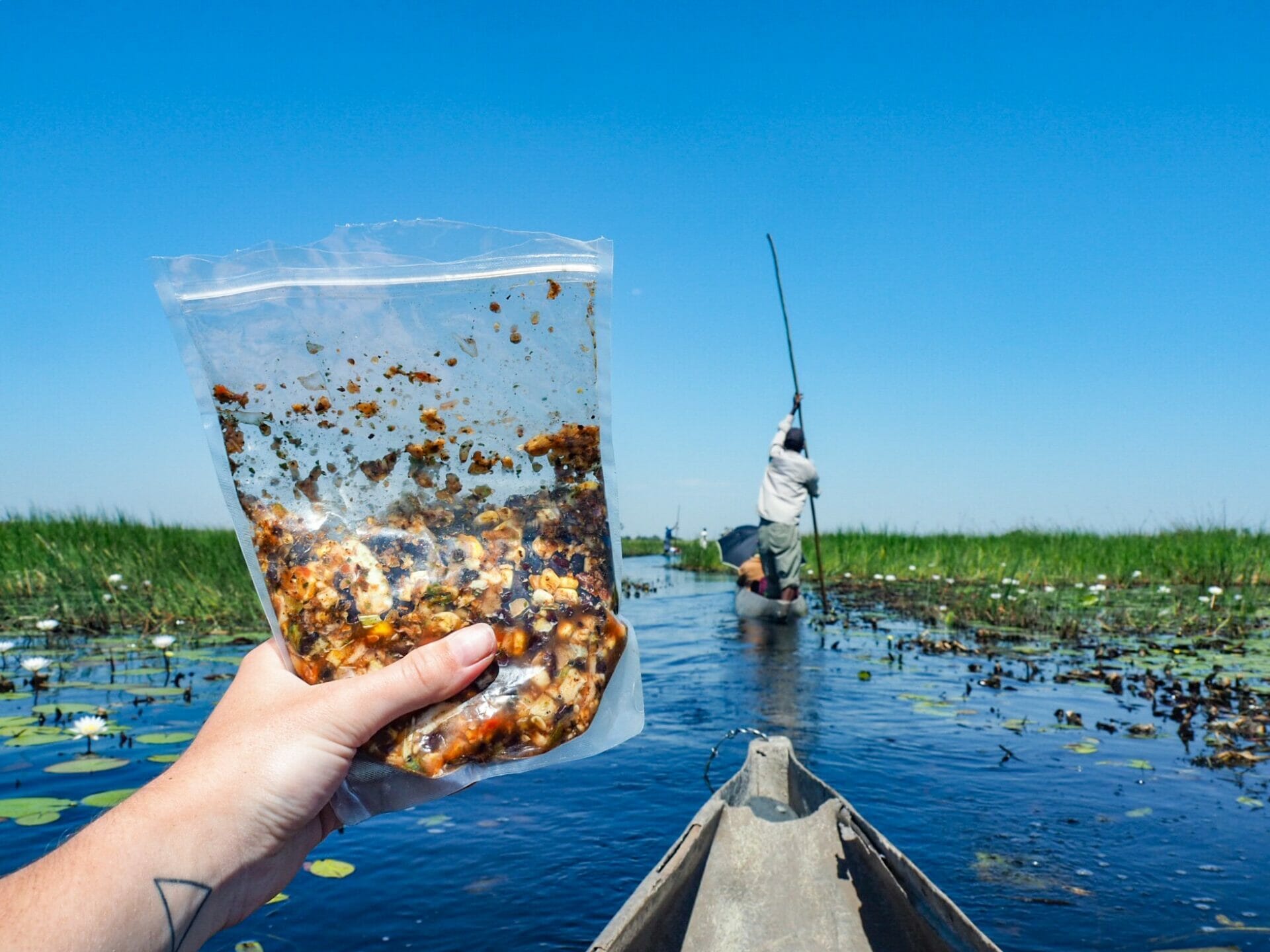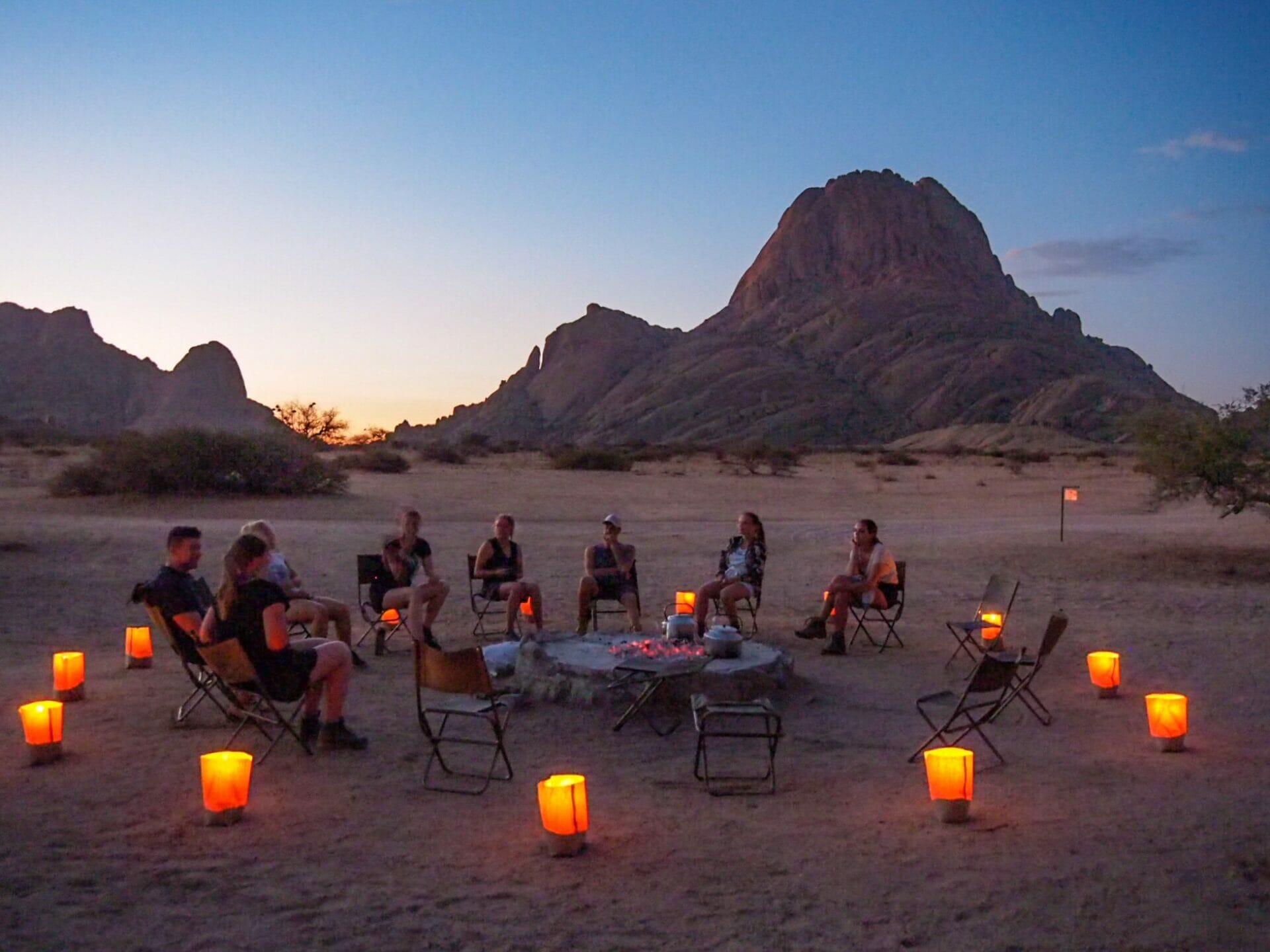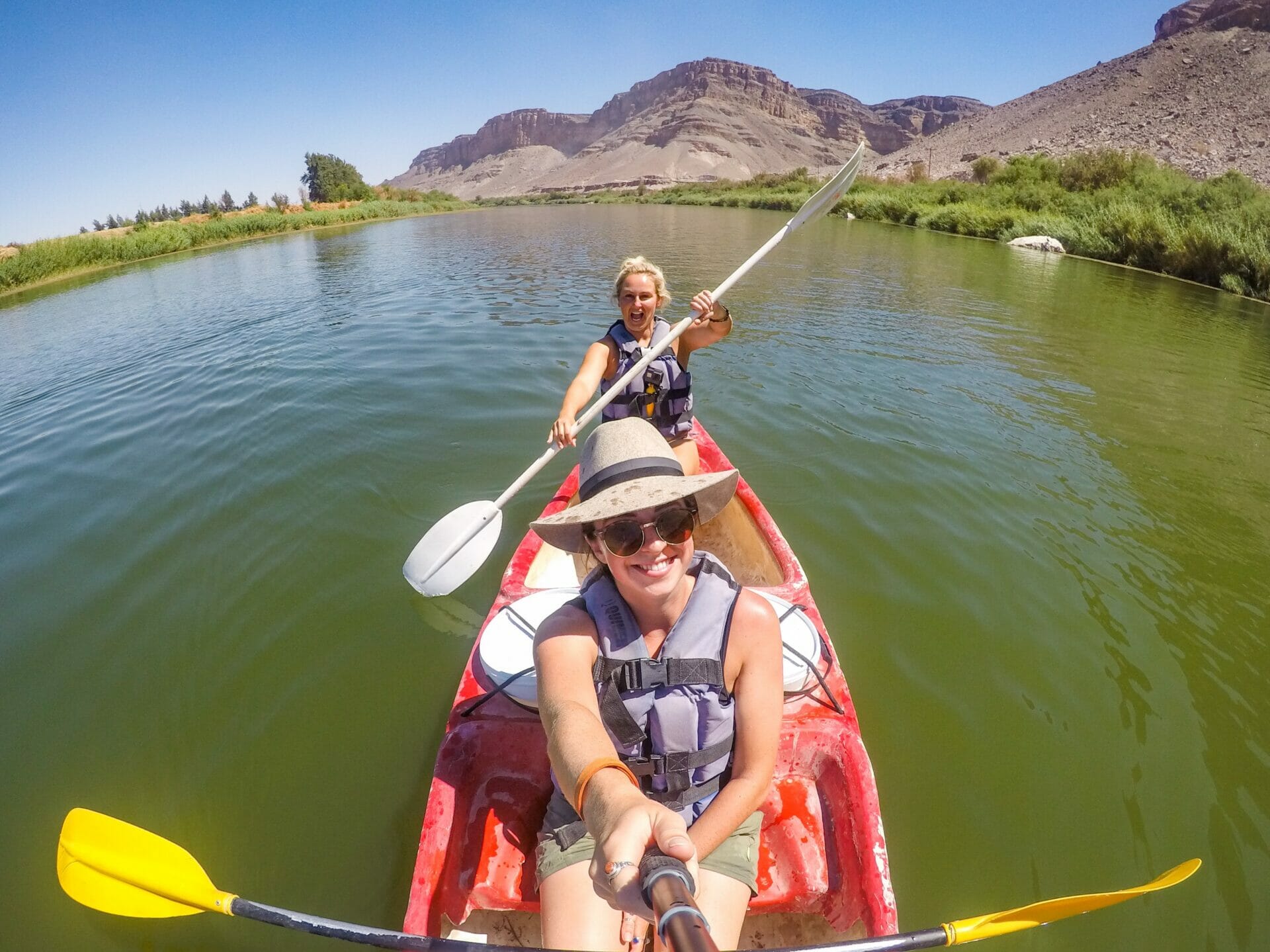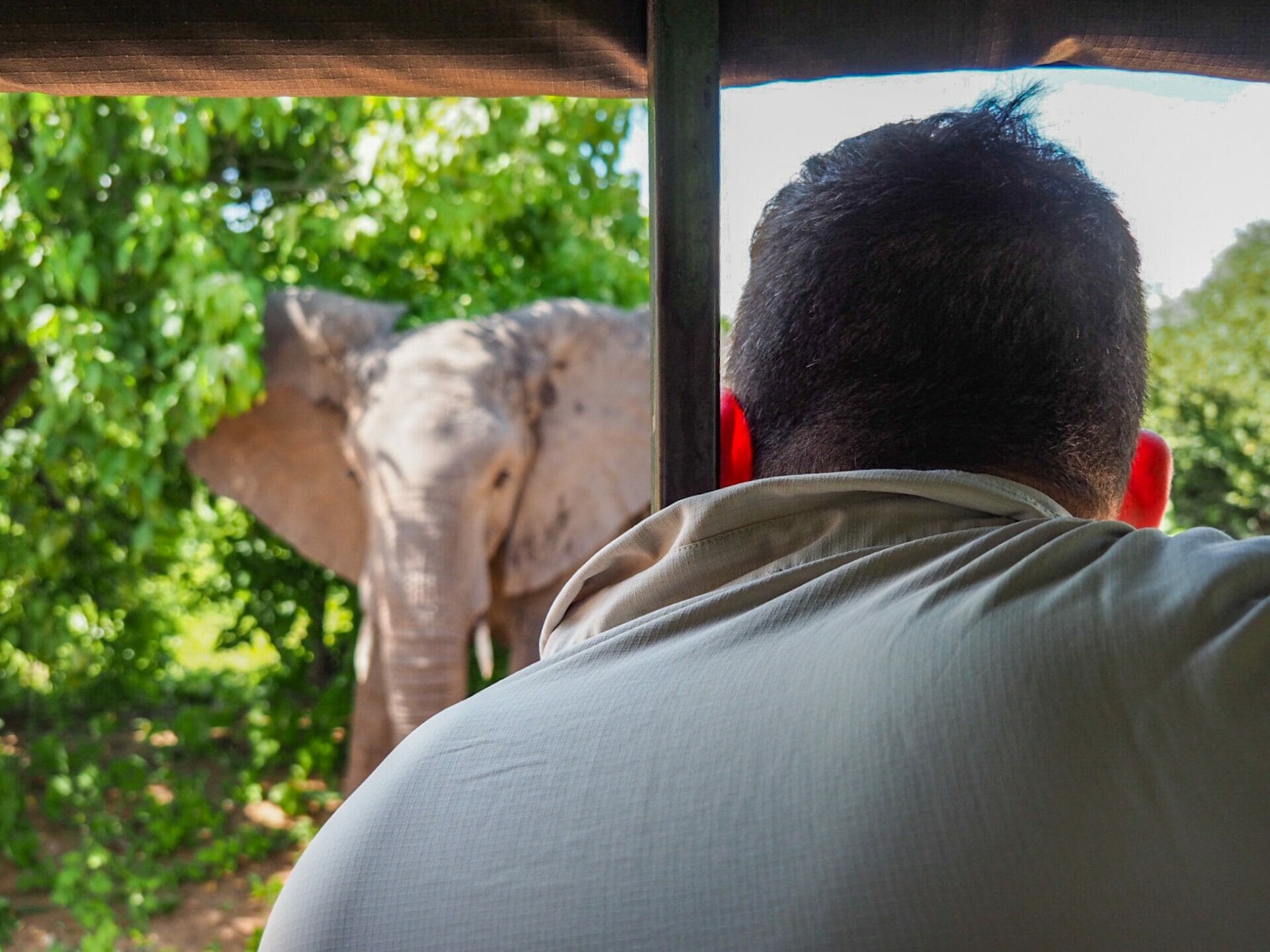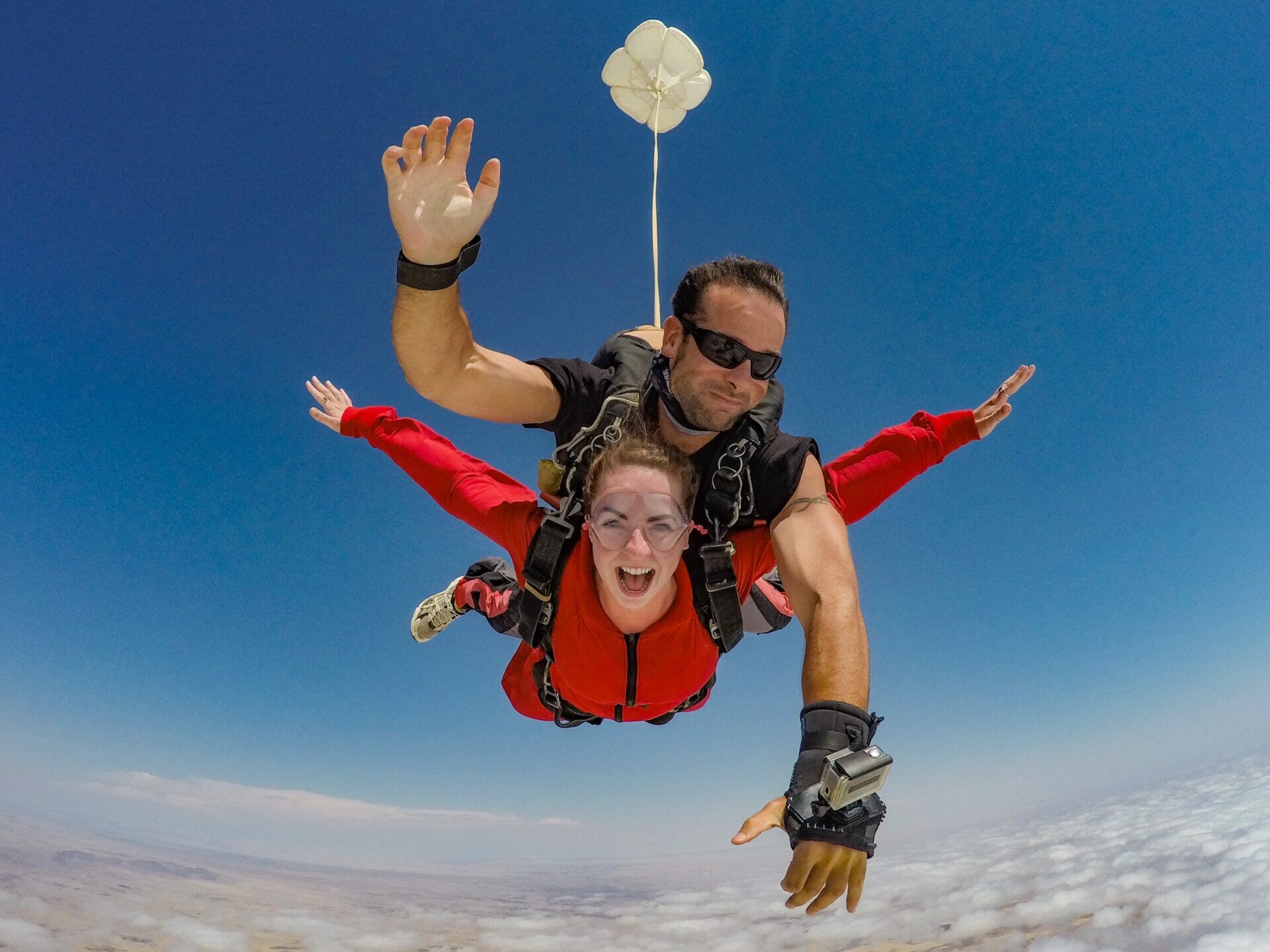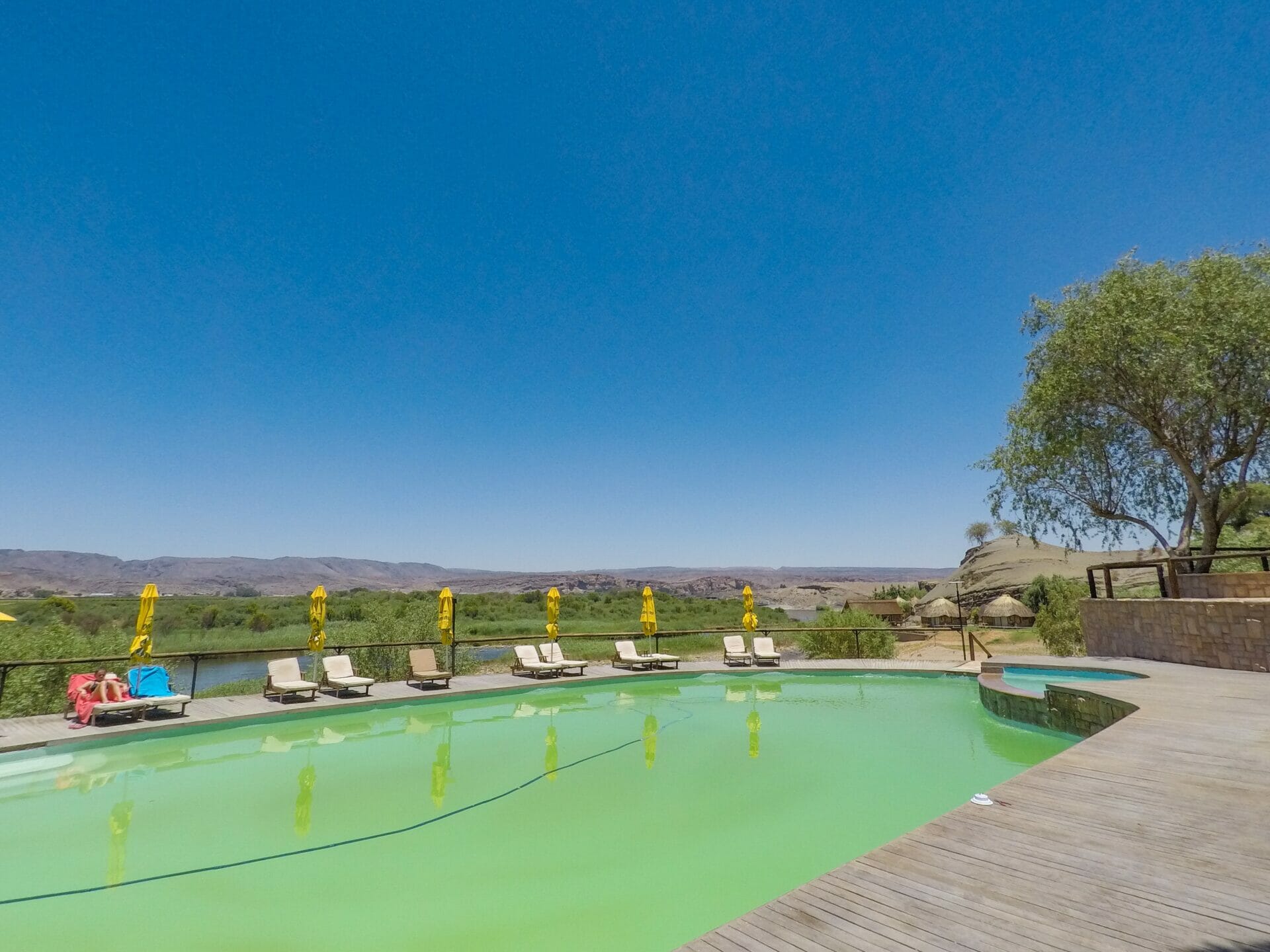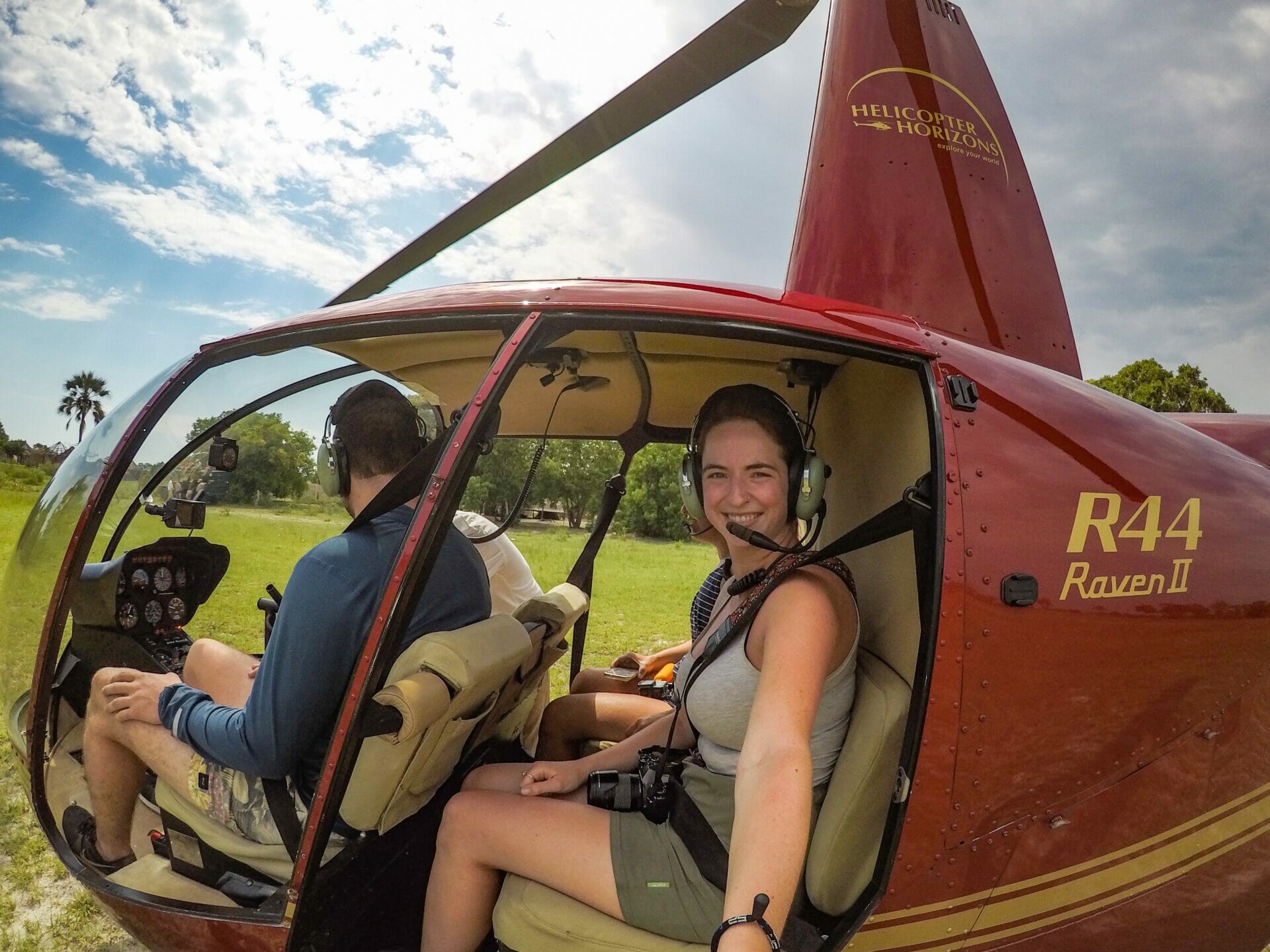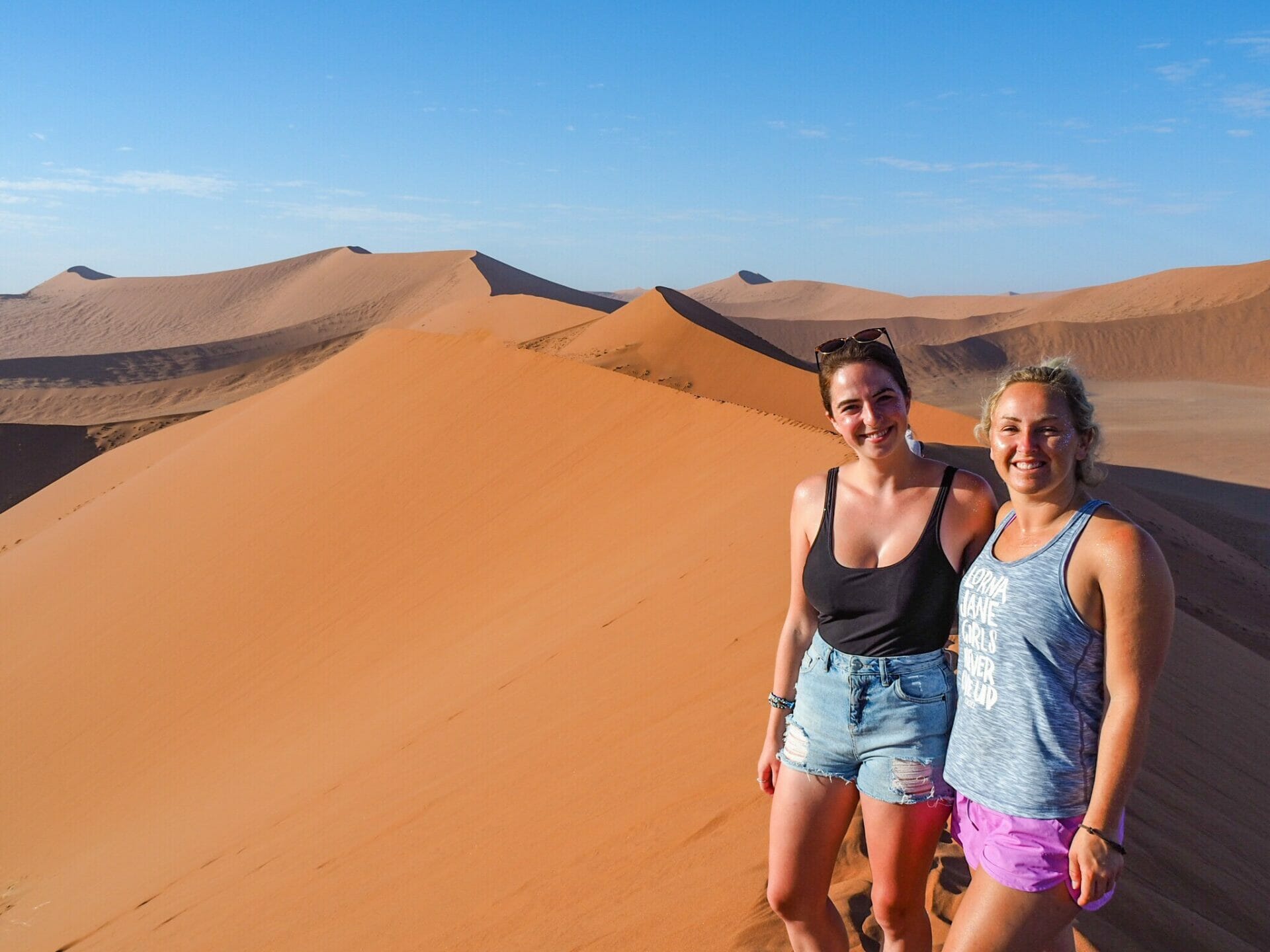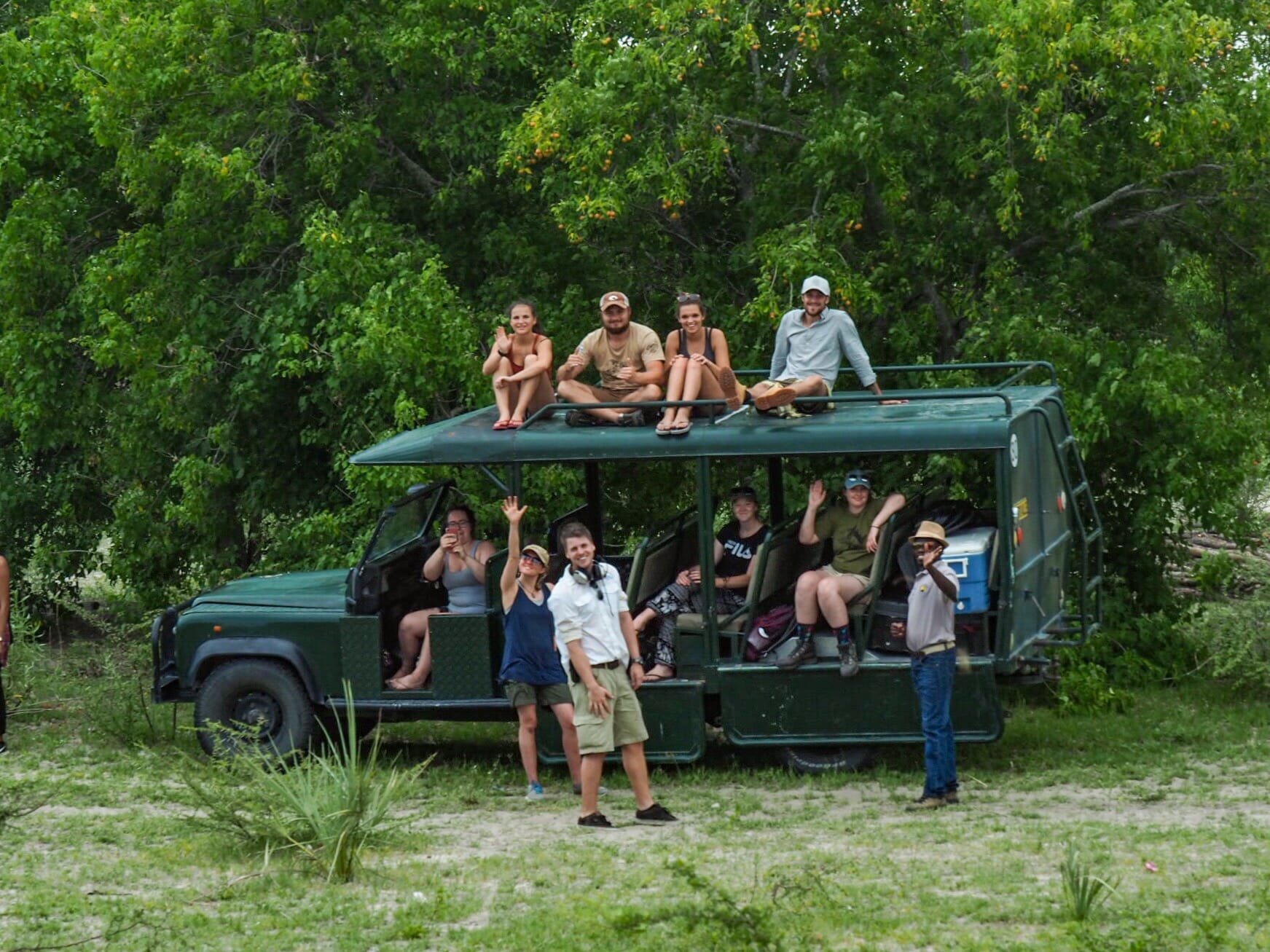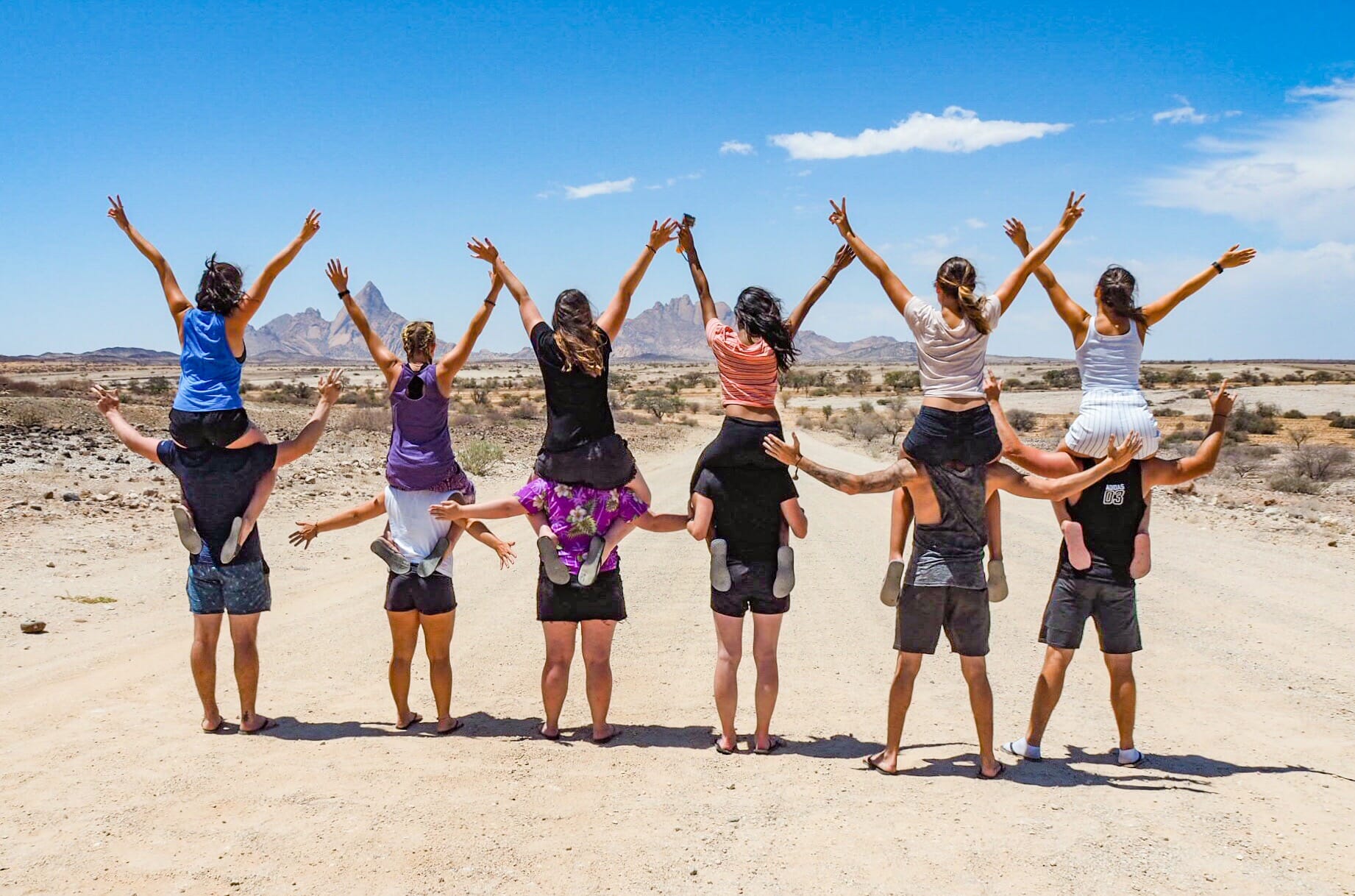
This content has been archived. It may no longer be relevant
Last Updated on 23 May 2025
I was admittedly hesitant about signing up for a tour in Africa. I know it’s unfair, but I tend to stick my nose up at any kind of organised tour, (incorrectly) thinking they are all filled with 20-something’s whose only goal on the trip is to get blind drunk every night and (wrongly) assuming that a tour isn’t “real” travel. The more I looked into covering Zambia, Botswana, and Namibia by myself, though, it became clear that it just wasn’t possible in my time frame!
What really convinced me that I needed to consider a tour was reading about overlanding. So many people say that it’s the only way to see the real Africa, which makes sense— southern Africa’s greatest treasures aren’t always conveniently located by a main airport (or even by a main road). The African experience is about seeing the remote villages, getting off the tourist track and away from the more built-up cities, and discovering the heart of this vibrant and awe-inspiring region. I wanted to explore the places I couldn’t read about in Lonely Planet and visit areas so remote that I wouldn’t have been able to find them on my own. And that’s exactly what I got.
- The gang walking down
- Kerri on the lookout for animals
- Some friendly fighting
I didn’t know exactly what to expect before setting out on my own overlanding tour, but my socks were promptly knocked off as we travelled for 3 weeks from Livingstone, Zambia, through Botswana and Namibia, to reach Cape Town, South Africa. I just wanted to compile a little bit of overlanding knowledge into a post for anyone considering this kind of trip through Africa, hopefully it will provide an idea of what the experience is like and further convince you to book one right now. Of course, not all overlanding companies are created equally, but most of the other providers that we crossed paths with were driving similar trucks, operating in a similar fashion, and visiting similar places, so this post, while it doesn’t apply to every single company out there, should still provide a decent idea of what you can expect while overlanding.
This post is Part I in a 3-part series on Overlanding in Southern Africa. Read the other posts here:
The truck
In essence, overlanding is a lot of driving. I suppose that’s pretty obvious, but I doubt anyone is truly prepared for just how much time you’ll be spending in your truck on an overlanding trip through Africa. It’s an enormous continent, things aren’t very close together, and you’re trying to cram in as many incredible stops as possible, so it’s not uncommon to spend 8 hours on the road cruising to your destination (our longest drive was close to 10 hours, but we also had days with no driving or just 1 hour on the road). In that regard, the truck is more your home than even your tent.
Save for a few fancier options, most companies use similar trucks to Acacia’s, which are 24-seater, 4WD monsters that carry the entire kitchen and camp underneath, all of the passengers and belongings in the back, and the guide and driver up front. The seats usually recline and there are also a number of seats at the back that surround a table, which are quite useful for playing card games or for trying to work on your blog during your long day on the road. If you’re lucky, the trip won’t be fully booked so you can spread yourselves and all of your bits out across the truck, laying across two seats to nap and claiming double the overhead rack space for your snacks. We had only 11 people, and still it was difficult to imagine having anymore..
- Everyone passed out in the truck
- Our overlanding truck
- The lockers holding all of our stuff for the next 3 weeks
One of the main perks of overlanding is that you get to see all of the Africa in between the main towns, so there are enormous windows perfect for watching the countryside and locals fly by outside. The unfortunate news is that very few trucks, and certainly not in this price range, have aircon. Surprisingly, not many even have curtains to keep the early morning or afternoon sun off your legs. On several different occasions, we found ourselves embarking on multi-hour drives in 45C heat, during which time the truck completely transformed into a Swedish sauna. It was not fun, and we pretty much had no choice but to sleep because it was simply too painful to be awake. We also became well acquainted with “African air-con”, which is basically just rolling all the windows down and sticking your head out like a dog to try and get a bit of cool breeze through your sweaty hair.
At the back of the truck, there are a number of large lockers for all of your belongings (see photo above). A 50-70L backpack will easily fit inside (although not a large suitcase), but it’s still a challenge to keep all of your bits organised in that space for weeks on end. Because, not only will you have all of your clothing and personal items and tech gear in that locker, you’ll also have all your camping stuff, so try to store your pillow and sleeping bag in the overhead shelving and keep your food under your seat to free up a bit of room. If you have a small group, you can also claim multiple lockers and really spread yourself out, which helps enormously, but still expect to be losing things in a pile of your own crap and also for your dirty clothes to constantly be mingling with your (few) clean items. It’s unavoidable.
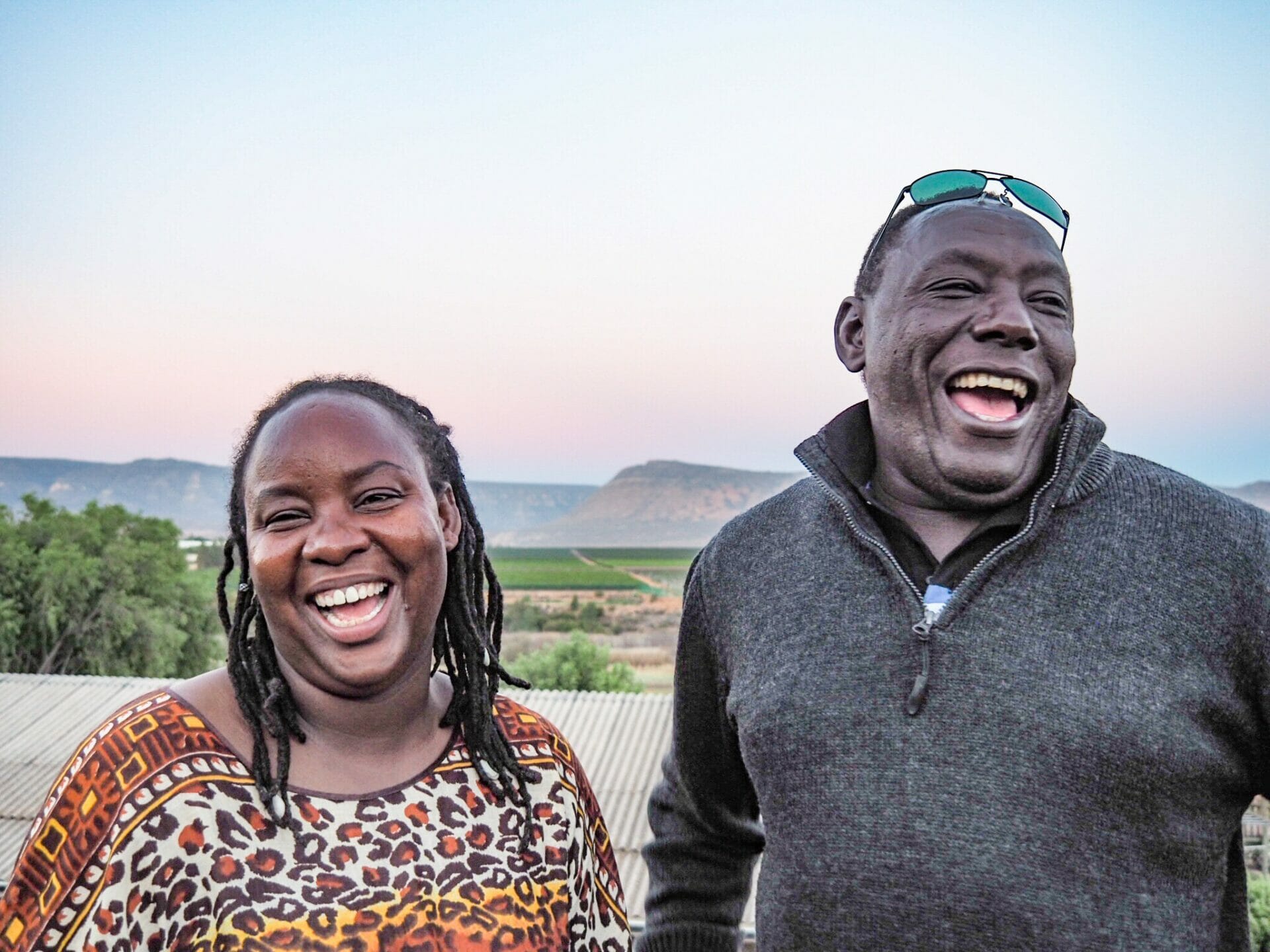
Rachel & Sam
The guide & driver
Sitting in the front of the truck are your driver and your guide. During game drives or any other particularly interesting stretches of driving, the guide will usually come into the back of the truck to tell you a bit about the area, but you don’t typically interact with them too much in the truck. Once at camp, however, the guide and driver, with your help, will set up the camp kitchen, organise any of your activities for the afternoon, and then get cooking.
Both our driver, Sam, and our guide, Rachel were absolutely beautiful people who made the experience so much better. They were a great resource for questions about Africa and were always ready to help, whether it was coordinating an independent activity, making phone calls on our behalf, reserving a restaurant for us on nights we were on our own, or just ensuring that we always had what we needed with us before setting out on a new adventure. She was a bit like our group mum, and I don’t know what we would have done without her.
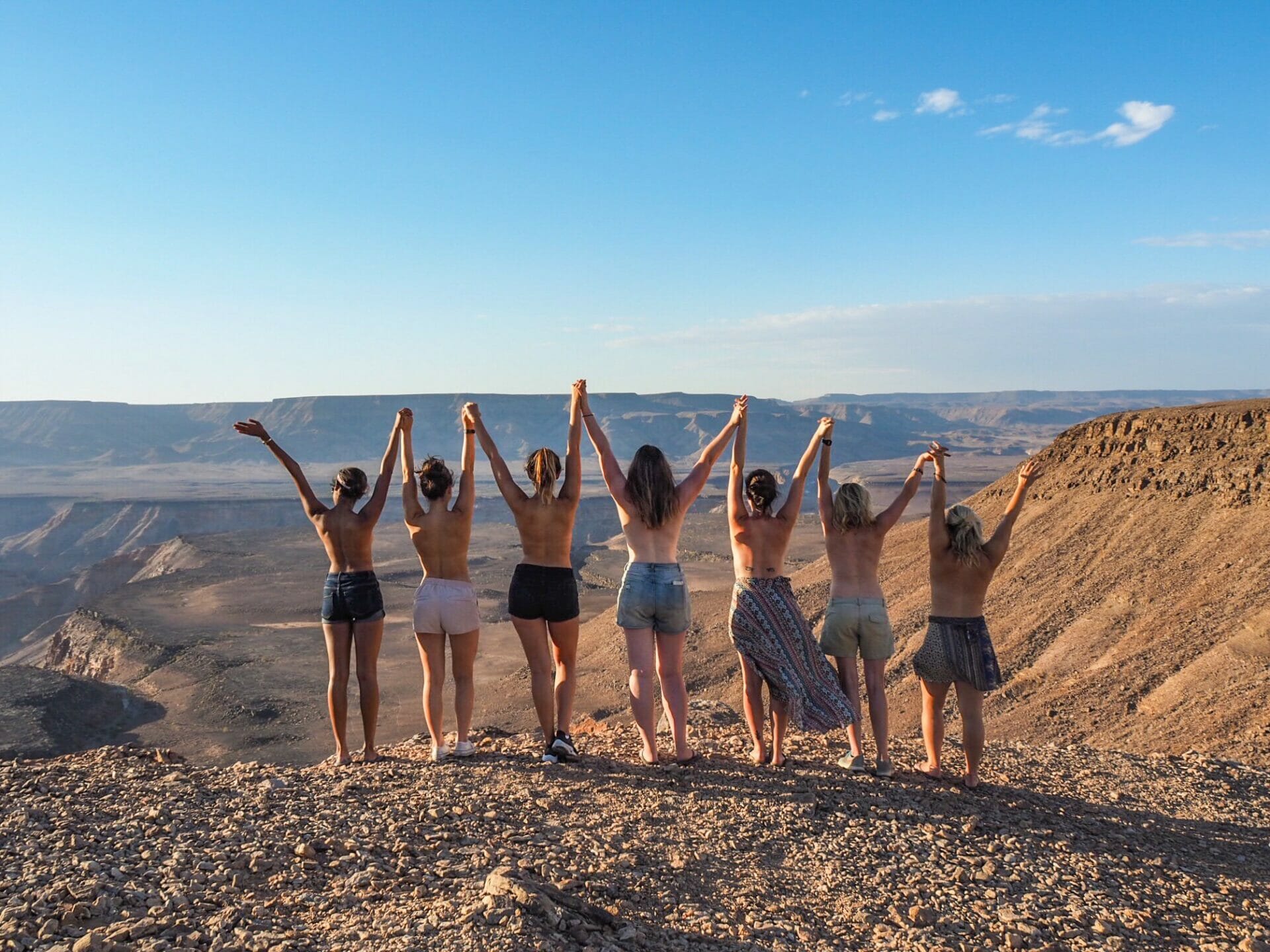
The gals
The people
I mentioned before that a lot of my hesitation about travelling with a tour was to do with the kind of people who join tours. Having never been on one before this trip, I had a very “club bathroom tour of Europe” Contiki-like impression of all organised tours— that is, an enormous and cliquey group of 20-something partiers who just want to sleep with every other person on the bus and get drunk every night. I am thrilled to report that this couldn’t be farther from the case for overlanding tours. In fact, many of them were just like me: wanted to see southern Africa, but realised that they would only fit in a fraction of this itinerary if travelling alone.
Probably the nature of the tour itself does a lot to limit the people who are joining. You’re sleeping every night in tents, helping cook and clean, and you won’t see many clubs in the middle of the desert, so I think it attracts a different type of traveller in the first place.
- The gang
- Di, me, Nicole, and Grace feeling very burnt on Big Daddy
- Tess, Kerri, Nicole, Me, Kate, Di, Grace.
Our group of 11 ranged in age from 19 to 29, and was almost entirely female. The group was also almost exclusively Aussie, except for 2 Germans and 1 Pom. Callum and I were the only couple, then there were 3 sets of girlfriends travelling together, and 3 solo travellers: Kate & Tess from Perth; Di from Brisbane & Grace from Bendigo; Melina & Emelie from Berlin; Kerri from London; Nicole from Newcastle; and Lucas from Brisbane. It was a close split of students (including us postgrad students) and professionals ranging from real estate agent to teacher to nature guide to travel agent.
We got to know people pretty well over the course of our 3 weeks on the truck as we spent time singing to 90s music, swimming, teaching each other card games, inventing elaborate riddles, and just generally talking shit. We often indulged in a drink beside the camp pool in the afternoons, and a small group of us even went out to a live music bar in Windhoek, but the vibe of our group was a lot more about experiencing Africa than drinking, which I really loved.
I feel incredibly lucky to have gotten the group we did, as they really made the experience. I actually feel like I made some new lifelong friends, many of whom live only a few hours away. It was also truly incredible to spend my birthday, after the tour ended, surrounded by these lovely new friends who went to great lengths to ensure that my day was special. The people are just as much of the overlanding experience as anything else, so come ready to meet some amazing new friends.

Sunset in the Namib Desert
Participation
Many overlanding tours, to reduce the number of staff necessary and therefore keep costs down for you, operate on a participatory basis, which means you will be helping with the cooking, cleaning, and packing that keeps the trip running smoothly. It’s honestly not a big deal, and it was even a good opportunity in the beginning to get out of your way and chat to the guide and the other people in your duty group (clean the truck together once and you’ll be swiftly on your way to friendship). On our tour, a rotating roster was designed and we were sorted into 3 groups to tackle the chores: one night, your group would sweep and mop the truck; the next night, your group would chop veggies for dinner; and the following night, your group would wash up the pots and pans. None of our chores ever lasted longer than 20 minutes, so the commitment is minimal.
In addition to the rotating roster, everyone is responsible for setting up their own tent and washing up their own dishes after breakfast and dinner every day. When we packed up the tents and our sleeping mats, we also needed to load them back into the truck, as well as help with packing up the kitchen and shifting food crates under the truck. Really, it’s no more tidying than you would do to your own kitchen and bedroom every day, and it flies by when everyone is pitching in— even with a small group of 11, I wouldn’t need to carry more than 2 crates to the truck before it was finished and I could settle into my seat for the day’s drive.
Inclusions
When looking into overlanding tours, you should be sure to consider what’s included, as this can vary considerably between companies. In booking my tour, I paid $1900AUD (booked in 2017 during a special promotion, approximately 8 months before travel) and then an additional $400 in US cash paid directly to the guide upon arrival (which she changed over into local currencies as we travelled and used to buy food, fuel, etc for the trip). This additional $400 was officially for the safari in Chobe National Park, a journey into the Okavango Delta, and a visit to Sossusvlei, and I truly wouldn’t have wanted to miss any. Everyone on my tour paid for this activities package, and although you could, in theory, just pay the tour cost and sit out these “extras”, it would be an enormous waste to come all this way and miss out. So that’s a bit over $2400AUD for 3 weeks, which really isn’t bad.
That money covers your accommodation every night, which is usually the tent they provide for you, but on a few occasions is a hostel or pre-erected tent. It also includes all the transport and driving that you do, obviously, and most of your meals. On a few days, usually when we were in larger towns, we had the entire day to ourselves, which meant breakfast included but lunch and dinner on our own so we could join day tours that included lunch or go out to dinner as a group at a nice restaurant. We were also responsible for snack foods and all of our own drinking water, stopping typically every second day at a supermarket for us to stock up. (I actually really disliked that the drinking water was not provided, as we went through a ridiculous amount of plastic as a group and constantly struggled to fit everyone’s drinks into the esky, but that’s another story.)
Many of the activities were included, especially with the additional package, but there were still a number of optional activities available along the way that cost extra money. I’ll speak a bit more about this below. Compared to other companies, ours was at the cheaper end of the spectrum, still with great reviews, hence our decision. However, in speaking to a girl in our group who overlanded with another company prior to this leg of her trip, maybe the price difference isn’t that much. She said she paid around $2500 for 2 weeks in East Africa (which, granted, is a different region and the cost of things would have been different), but she said that it was so inclusive that she only spent about $50 of her own money the entire time. Water was included, snacks, all meals, all activities, AND air conditioning. So just map out a budget before you make a decision, the cheaper company may not actually be the cheapest option in the end!
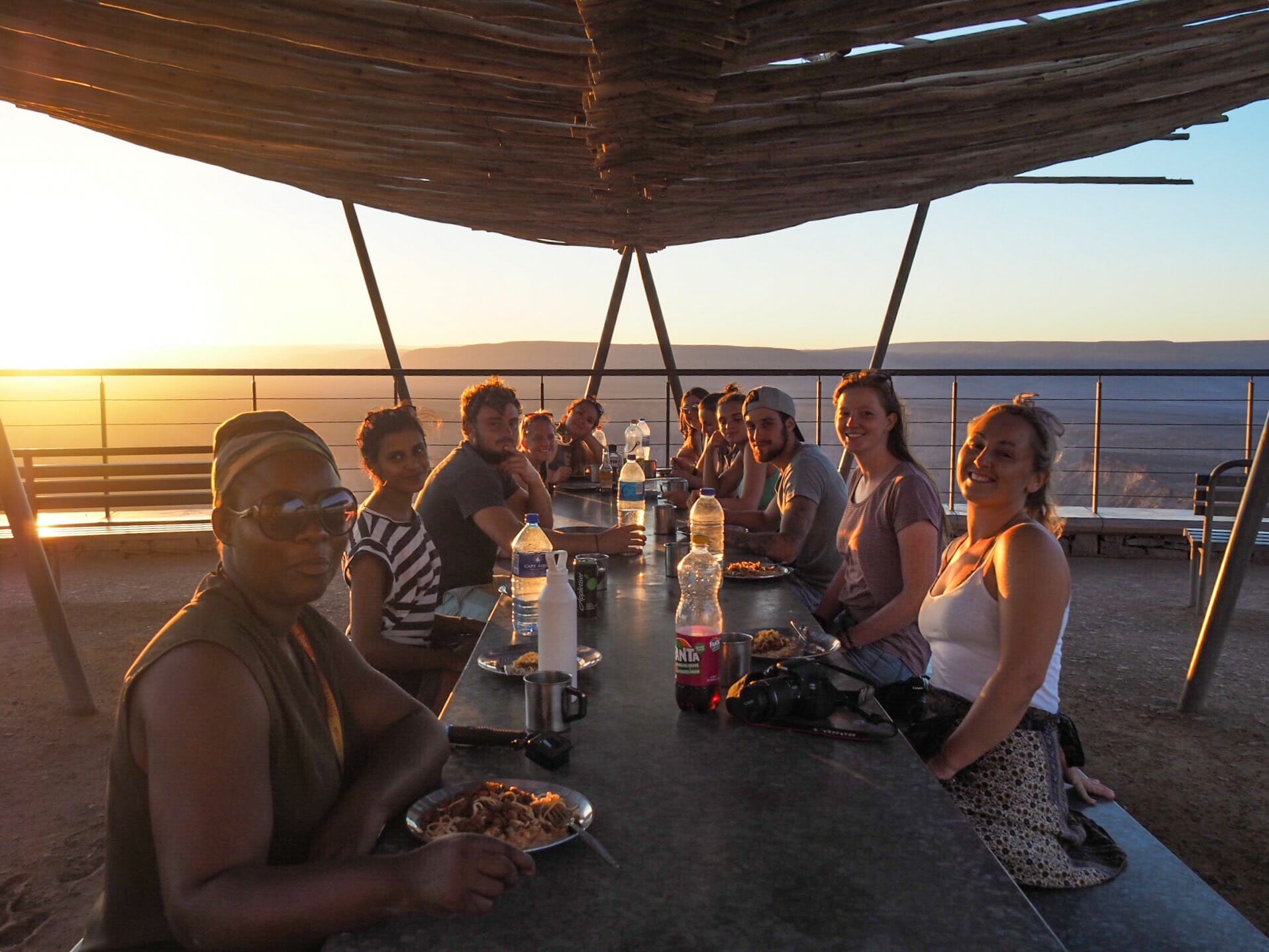
Dinner with a view
The food
For the most part, overland tours will include breakfast, lunch, and dinner with the group, but of course the specifics of your food are likely to vary widely based on what company you’re with and also your guide who’s doing the cooking (some companies even have designated chefs, actually). For us, breakfast would either be hot or cold, depending on how much time we had (i.e. how much driving we had that day). Cold breakfast consisted of cereals, toast and assorted spreads, tea and coffee, etc, but most mornings we would have time to whip up some eggs and bacon as well. We even had french toast one day! Depending on what part of Africa you’re in and the time of the year, there may also be fresh fruit.
If it was an exceptionally long day on the road, we would pack sandwiches at breakfast and eat them for lunch on the road. These were just standard lunch meat, cheese, sauce, and salad sandwiches on white bread, so nothing terribly fancy, but nice and quick to prepare at 530am. Most days, though, we would pull the truck over around midday in a shady spot and our guide would prepare an actual meal for us. This might be chicken pasta salad or even leftovers from dinner the previous evening, often accompanied by a green salad and fresh orange slices, and it was always tasty.
Dinner was definitely the main event, though. As part of our cooking duty, we would meet our guide around 530pm to chop several dozen carrots and onions and then she would spend the next 2-3 hours creating a culinary masterpiece, never revealing to us what the dish would be until we were sitting down. I wasn’t really expecting the food to be any good from other things I’d heard about overlanding, just because the menu is limited by the fresh food available along the way and also the guide’s interest/skill level in the kitchen, but we got incredibly lucky and there wasn’t a single meal of which both Cal and I didn’t go back for seconds.
- Mountain food in the Delta
- A particularly glamorous meal in Spitzkoppe
- Dinner with the gang
We had a great mix of more western food (spaghetti bolognese, bbq pork and potatoes) and African food (braai, bobotie, curry and chapati, pap), and our dinners always consisted of a meat, starch, and veggie. To be honest, it’s probably the best I’ve eaten in a long time in terms of a well-balanced, healthy diet. In speaking to people who had travelled with other companies on overlanding trips, there are some companies consistently churning out fantastic meals and other companies that just do not prioritise it. There is also a substantial variation in cooking participation: we really only spent about 20 minutes for our cooking duty, never doing more than washing and chopping vegetables before leaving Rachel to the rest, but other tours might ask you to help for the entire 2 hour cooking process or even cook the whole meal on a designated night. I must say, I’m really happy that the guide did all of our cooking. And no, not just because I don’t want to cook, but because we got to try a number of amazing local dishes that we never would have tried otherwise and food is definitely one of the best parts of travelling.
As for snacks, with most companies you will be responsible for buying any extra snacks to have on the truck during one of the frequent “shop stops”. Thankfully, it is quite cheap to buy chips and biscuits and fruit in Africa, so budgeting $5 a day would be more than enough. In addition to these snacks, you may have to actually buy your own water, which, although cheap (about $3 for 5L), is very annoying. This is one of my biggest bones to pick with Acacia, as some other companies provide cool drinking water for you. I think this would be an incredibly inexpensive inclusion that would do a lot to cut down on plastic waste generated on tour and also to avoid anyone running out of water on a hot day in the truck (people will share with you, but still). At the end of the day, it’s probably not a reason to go with one company over another, but it does say a lot about that company’s focus (or lack thereof) on responsible tourism and environmentalism.
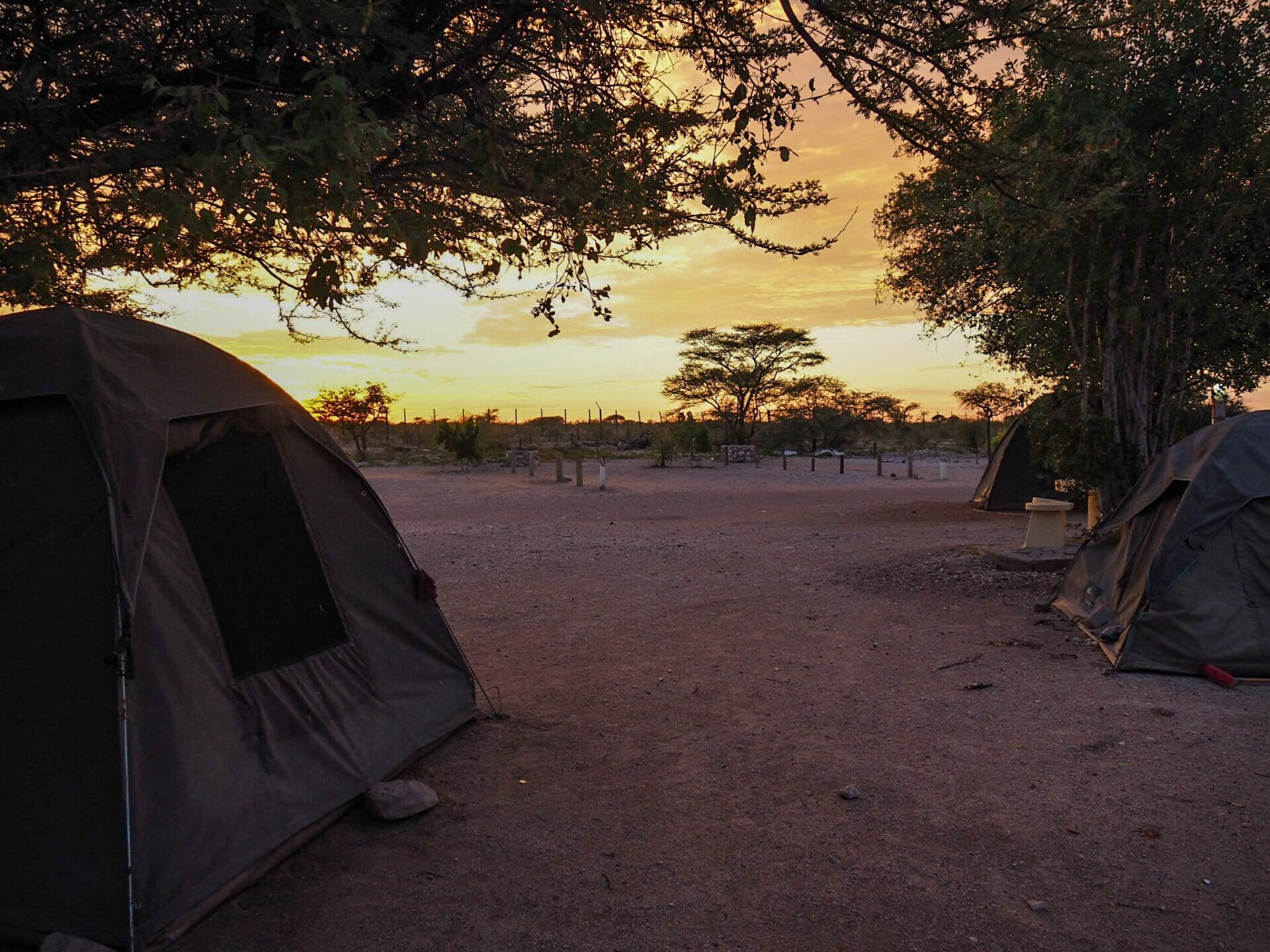
Sunrise from the tent
Camping
All overlanding companies, unless of course you’re participating in an accommodated tour, will provide you with camping equipment, including a very heavy duty tent, rain cover (the guide will just get them out if the weather is looking questionable) and sleeping mats (you can have 2 if it’s not a full tour, which I recommend). You will be responsible for setting up your tent and packing it away each day, but with two people it’s a pretty quick job. If you are travelling alone, you will be paired up with someone else (the same gender, obviously) to share a tent with, unless there are odd numbers and then you have the tent to yourself, which is what happened to me after Cal’s leg of the trip ended. You’re also responsible for bringing a sleeping bag, sheet, and pillow (I’ll discuss this at length in Part II of this post, but basically you are going to want a full size pillow and a sheet to go over the sticky vinyl mattresses to avoid uncomfortable midnight sweats).
At many of the campsites, there is an option to upgrade to a room, which can vary from $10- $100 depending on where you are. There are people who probably upgrade every night on their tour, but during our entire 3 weeks I only upgraded on our last night, and still half of the group opted to stay in their tents. It was about $30 each for a double room that I shared with another girl, and I can’t say how nice it was to be in a bed and have a private shower, but it was the aircon that really convinced me.
At the end of the day, I’d do it all over again as a camping tour, not just because it was significantly cheaper, but also because it was a lot of fun falling asleep to the sounds of nature and watching the stars through the tent windows every night. One night, we even slept on top of a mountain on just our mats and saw about 20 shooting stars before drifting off. Pure magic.
The activities
Throughout our 3 weeks on the road, we participated in countless activities that really made the agonisingly long drives worthwhile. Obviously the activities will vary depending on your itinerary, and the included/excluded activities will also depend upon your company, but expect to be doing an activity at least every second day. That doesn’t necessarily mean that on the days with no activities you’ll be sitting around and twiddling your thumbs, it just means that you don’t have a scheduled game drive, nature walk, or other group outing. Trust me, you will come to treasure those days just as much for the much-needed rest & relaxation.
On our off days, we would swim in the camp pool (all but 2 of our camps had pools), play card games, catch up on our photo editing/journal writing/washing, and just generally recover from the long drive and high-energy activities of the day before. I was not bored for a single second on this trip (if anything, I was worn out from the nonstop fun).
Read these posts if you’re interested in reading more specifically about the activities we participated in while overlanding:
WHITE WATER RAFTING THE MIGHTY ZAMBEZI RIVER IN LIVINGSTONE, ZAMBIA
5 WAYS TO ENJOY VICTORIA FALLS IN ZAMBIA & ZIMBABWE
ON SAFARI IN CHOBE NATIONAL PARK, BOTSWANA
ELEPHANT SANDS: BOTSWANA’S COOLEST CAMPSITE
ADVENTURING THROUGH BOTSWANA’S OKAVANGO DELTA BY LAND, WATER & AIR
MEETING BOTSWANA’S SAN BUSHMEN
OUT ON THE TOWN IN WINDHOEK, NAMIBIA
ANIMAL SPOTTING IN NAMIBIA’S ETOSHA NATIONAL PARK
SLEEPING UNDER THE STARS IN SPITZKOPPE, NAMIBIA
WHERE THE DUNES MEET THE SEA: SKYDIVING IN SWAKOPMUND
QUADBIKING THROUGH THE DUNES IN NAMIBIA
CROSSING THE TROPIC OF CAPRICORN
EXPLORING DUNE 45 & DEADVLEI IN THE NAMIB DESERT
SUNDOWNERS AT NAMIBIA’S FISH RIVER CANYON
CANOEING ALONG THE ORANGE RIVER
A RETURN TO THE FINER THINGS IN SOUTH AFRICA’S CEDERBERG WINE REGION
- Cal locking eyes on an ellie
- Tempting to spend the whole day by the pool..
A typical day overlanding
Wake-up time varied based on the driving and activities schedule for the day, but we’d always get up quite early. Breakfast was typically before 6am, and you usually need to have your tent packed down and back on the truck before that time, so most of our alarms were around 530am. After wolfing down breakfast, often in the dark, we would wash our own dishes and help pack up the kitchen before piling onto the truck. Most days, our activities were in the afternoon, so we would spend the morning driving to our next camp. During this time, we would sleep, chat with other people in the group, listen to music, read, or play cards.
Every few hours, we would stop for a bathroom break (commonly a “bushy bushy”, meaning that the bathroom is actually a bush on the side of the road— there is always toilet paper and hand sanitiser on the truck) and most days we also had a “shop stop”. This is where our guide stocked up on fresh ingredients for breakfast, lunch, and dinner, and also where we could buy water and snacks for the day. Lunch might be on the road, meaning that we packed ourselves a sandwich at breakfast, the truck might stop for lunch in a shady spot, or we might even have made it to our camp in time for lunch.
Once at camp, we would have maybe an hour to ourselves before departing on our game drive or nature walk or other activity, and then we would have an hour or two in between that activity and our dinner. During this time, the group on cooking duty would go chop some veggies and then the rest of the time would be free to lounge around the pool and relax. Depending on how hot the day was, we might wait until after dark to set up our tent and lay out all our bedding, just to avoid turning our sleeping quarters into a hot box. Around 830pm, we would gather for dinner and chat with our guide about the plan for tomorrow and about the places we’d just visited. We would wash up our dishes, the groups on truck cleaning duty and washing up duty would do their bit, and then we would go watch animals at the watering hole, stargaze, or just hang out until crawling into our tents for the night.
- The gang back at the safari truck
Hopefully this guide has given you some idea of what to expect on an overlanding tour! I’m far from an expert on the subject, but I will do my best to answer any questions in the comments below.
Happy travels!

